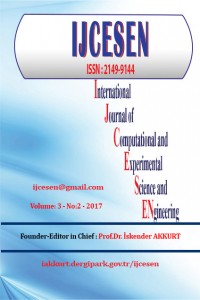Abstract
Cyclones
are separation devices that use centrifugal forces to remove dense phases from
two phase flows. There are many application areas of cyclone separators ranging
from industrial processes to domestic applications due to their simple
structure and lack of movable components. For this reason, they are commonly
preferred where two phase fluid flow accommodated and separation is required.
In this study, axial and reverse flow tangential inlet novel cyclone geometries
were introduced to configure different separation space and to reduce pressure
drop in comparison with traditional cyclone geometry. Although the construction
of a cyclone is simple, the cyclone flow and separation process are very
complex. Therefore, CFD is quite appropriate provided that the proper
mathematical models and computational techniques are used. 3-D and unsteady
governing equations were used for the turbulent cyclone flow. Hexahedral meshed
domain was solved by using Fluent CFD software. Eulerian approach was used to
solve the flow field and transient Reynolds Stress Model (RSM) with the
scalable wall function. Lagrangian approach with DPM (Discrete Phase Model) was
used to calculate discrete phase by releasing particles from inlet surface. CFD
calculations were run for different geometric configurations in order to
analyze performance of cyclones in terms of pressure drop, cut-off diameter and
grade efficiency. Axial and tangential velocity profiles are presented at
defined sections. The computational results of pressure drop, velocity field
and separation efficiency were also compared for the axial and reverse flow
cyclones at the same flow rates.
Keywords
References
- [1] I. Karagoz, A.Avci “Modelling of the Pressure Drop in Tangential Inlet Cyclone Separators” Aerosol Science and Technology 39:9 (2005) 57-64. DOI:10.1016/j.jaerosci.2013.01.010
- [2] A. C. Stern, K. J. Caplan, P. D. Bush “Cyclone Dust Collectors” American Petroleum Institute, New York, 1955.
- [3] Y. Zhu, K. W. Lee “Experimental Study on Small Cyclones Operating at High Flowrates” Journal of Aerosol Science 30 (1999) 1303–1315. DOI:10.1016/S0021-8502(99)00024-5
- [4] I. Karagoz, A. Avci, A. Surmen, O. Sendogan “Design and Performance Evaluation of a New Cyclone Separator” Journal of Aerosol Science 59 (2013) 57–64. DOI:10.1016/j.jaerosci.2013.01.010
- [5] F. Tan, I. Karagoz, A. Avci “Effects of Geometrical Parameters on the Pressure Drop for a Modified Cyclone Separator” Chemical Engineering Communications 39:3 (2016) 576–581. DOI: 10.1002/ceat.201500182
- [6] J. Oh, S. Choi, J. Kim, S. Lee, G. Jin “Particle Separation with the Concept of Uniflow Cyclone” Powder Technology 254 (2014) 500-507. DOI:10.1016/j.powtec.2014.01.057
- [7] F. Kaya, I. Karagoz “Performance Analysis of Numerical Schemes in Swirling Turbulent Flows in Cyclones” Current Science 94 (2008) 1273–1278.
- [8] M.Sommerfeld “Theoretical and Experimental Modeling of Particulate Flow” Lecture Series 2000-6 (2000) von Karman Institute for Fluid Dynamics, Belgium.
- [9] A. C. Hoffmann, L. E. Stein ”Gas cyclones and swirl tubes: Principle, Design and Operation” Springer, 2nd edition, 2008. [10] ANSYS, ANSYS Fluent 15.0 Theory Guide, Canonsburg, 2015.
Abstract
References
- [1] I. Karagoz, A.Avci “Modelling of the Pressure Drop in Tangential Inlet Cyclone Separators” Aerosol Science and Technology 39:9 (2005) 57-64. DOI:10.1016/j.jaerosci.2013.01.010
- [2] A. C. Stern, K. J. Caplan, P. D. Bush “Cyclone Dust Collectors” American Petroleum Institute, New York, 1955.
- [3] Y. Zhu, K. W. Lee “Experimental Study on Small Cyclones Operating at High Flowrates” Journal of Aerosol Science 30 (1999) 1303–1315. DOI:10.1016/S0021-8502(99)00024-5
- [4] I. Karagoz, A. Avci, A. Surmen, O. Sendogan “Design and Performance Evaluation of a New Cyclone Separator” Journal of Aerosol Science 59 (2013) 57–64. DOI:10.1016/j.jaerosci.2013.01.010
- [5] F. Tan, I. Karagoz, A. Avci “Effects of Geometrical Parameters on the Pressure Drop for a Modified Cyclone Separator” Chemical Engineering Communications 39:3 (2016) 576–581. DOI: 10.1002/ceat.201500182
- [6] J. Oh, S. Choi, J. Kim, S. Lee, G. Jin “Particle Separation with the Concept of Uniflow Cyclone” Powder Technology 254 (2014) 500-507. DOI:10.1016/j.powtec.2014.01.057
- [7] F. Kaya, I. Karagoz “Performance Analysis of Numerical Schemes in Swirling Turbulent Flows in Cyclones” Current Science 94 (2008) 1273–1278.
- [8] M.Sommerfeld “Theoretical and Experimental Modeling of Particulate Flow” Lecture Series 2000-6 (2000) von Karman Institute for Fluid Dynamics, Belgium.
- [9] A. C. Hoffmann, L. E. Stein ”Gas cyclones and swirl tubes: Principle, Design and Operation” Springer, 2nd edition, 2008. [10] ANSYS, ANSYS Fluent 15.0 Theory Guide, Canonsburg, 2015.
Details
| Journal Section | ICCESEN-2016 |
|---|---|
| Authors | |
| Publication Date | November 1, 2017 |
| Submission Date | October 25, 2017 |
| Acceptance Date | October 28, 2017 |
| Published in Issue | Year 2017 Volume: 3 Issue: 2 |


